NEWSLETTER 4th August 2018
Forthcoming K&DLHG event. Our final 2018 summer outing is the all-day coach trip to the historic Bristol Docks and SS Great Britain on Saturday August 11th. The coach leaves from outside St Peter’s Church, Kineton, at 8.45am. The very extensive historic Bristol Docks area has been completely refurbished, and now houses museums, historic boats, restaurants, bars, art galleries and Brunel’s SS Great Britain.
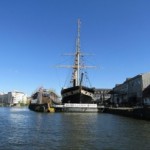
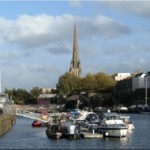
The cost, including entrance to the SS Gt Britain, is only £28.00 per person. We need to fill our coach so if you know of non-members who would be interested in coming on this trip please spread the word. You can still sign up to the Bristol trip by phoning Isobel (01926 640426) or Ilona (01295 670675) or by replying to this email (frekedj@globalnet.co.uk).
Report on the 20th July visit to the Rollright stones. David Shirt, a founder member of the Rollright Stones Trust, met about a score of our members at high noon at the Stones. And high noon it was, on one of the hottest days of the year so far. David explained the chronology of the three prehistoric monuments which comprise the Rollright Stones group as we headed off to see the Whispering Knights. The Trust has laid a very well-maintained walkway, no doubt as effective in mud as it was in the desiccated conditions of our visit. The Whispering Knights are the collapsed remains of a burial chamber or dolmen, dated to around 3,500BC, the early Neolithic period, when the first farmers were settled in the nearby valley, and when this monument would have been a feature on their skyline. The massive capstone was still poised on its three supports as recently as the 18th century, but the huge uprights at the portal remain standing.
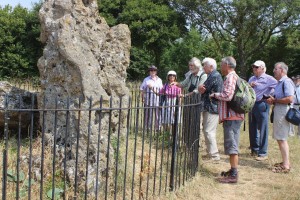
Archaeologists think that the human bones deposited in the chamber could be taken out for ritual or religious purposes. Despite the enormous efforts required to erect such structures, they appear to relate to the needs of small communities or even single families. The stones are all very local, and five and a half thousand years of erosion has carved their surfaces into fantastical convolutions.
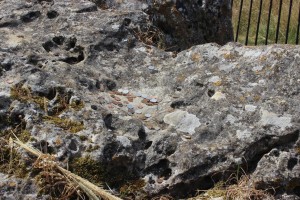
The evocative power these stones still have on the imagination can be seen in the many modern deposits occupying nooks and crannies in the stones – coins and corn dollies in particular. Some of these, no doubt, are merely intended to demonstrate somebody’s ability to aim, or they may represent the common impulse to throw coins in a fountain (itself a deeply atavistic thing?) but others clearly represent authentic modern offerings to spirits/genii, whose supposed powers may not be far removed from the deities of the original builders — the earth, the harvest, the sun etc., — particularly the sun during our visit. The offerings now go to help the Trust.
Then back up the track to the King’s Men stone circle, famed for being uncountable, probably because no two people can agree on what constitutes a separate stone in this very battered ring. Its construction dates to about 2,500 BC, a millennium later than the Whispering Knights. Again, it’s made of local stones, which increase in height from the entrance on the south, round both sides to the tallest stones opposite, although still not reaching much more than 2.5m high.
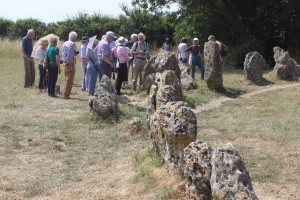
This form of circle is widespread in the west of the British Isles, and there is one almost exactly the same in Cumbria. These late Neolithic monuments mark a change in ritual habits; now large groups seem to be engaged in communal activities – feasts, markets, religious festivals, referenda, bureaucracy? – and these circles, together with other late Neolithic monumental features, seem to provide a community focus. They are often sited, like the Rollright circle, near boundaries and trackways. The King’s Men stones cannot be seen from settlements in the valley but are adjacent to the ridgeway, and the modern county boundary passes within a few metres.
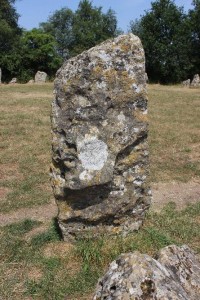
The oldest lichen in England (allegedly) can be seen on one stone, dated by its size to about 800AD
Nearby were some life-sized straw figures dancing in a circle. Our initial interpretation was that they represented the witch and her coven who had reputedly turned the king and his men to stone, but David Shirt assured us that they were the fairies in a Midsummer Night’s Dream. How easy it is to put sinister meanings on things!
Wilting in the heat (those witches were turning us into marshmallows) our hardier members crossed the road from Oxfordshire to Warwickshire and advanced another millennium to 1,800BC into the bronze age to examine the King Stone. Originally a straight standing stone it has been mutilated into a sinuous “S” shape by 18th and 19th century Welsh cattle drovers (and no doubt others) chipping off souvenirs or good luck tokens as they passed by on the ridgeway. The fateful bank which obscures the view of Long Compton, thought for many years to be a long barrow, is actually natural, although archaeologists have discovered bronze age burial evidence from an adjacent flattened round barrow. The view from the bank is panoramic, and the King Stone and the contemporary barrow sit at nearly the highest point of the ridge. We don’t know what such standing stones signified, other than obviously being striking points in the landscape. Isolated Saxon burials nearby may be another mark of how significant this place has been considered through the ages. A concrete cold war bunker is the 20th century’s contribution to the landscape
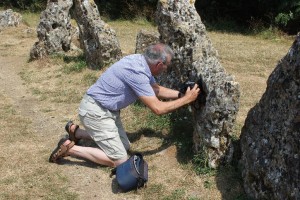
The three megalithic monuments span two millenia, and represent profound changes in economics, society and ritual but are all inter-visible, or they would be if it weren’t for the modern trees. Each successive society has found a way to incorporate the previous age’s ritual landscape into their own world, probably with no greater understanding of their original significance than our own faint inklings. The Rollright Trust, which receives no government support, is dedicated to ensuring that these monuments remain for future generations to enjoy and understand in their own ways, as we do in ours. David Shirt gave us the best informal but well-informed account of the stones and how we interpret them today.
Apart from a few determined picnicking members (well done), the survivors adjourned to Wyatts Farm Shop for refreshments and relief from the relentless heat.
Other Societies’ matters.
The London & North Western Railway Society, based in Kenilworth, has sent out an appeal to members of other societies who may have an interest in the L&NWR. They would like to hear from anybody with genealogical enquiries, archives, or information related to the railway company, as they have an extensive archive in Kenilworth. They offer to scan relevant documents up to 42 inches, free of charge, in return for a copy of the scanned material, the original, and copyright remaining with the owner. They are also planning training for conservation of archive materials. If this is of interest to you their web site can be found at: www.lnwrs.org.uk/
Other Local Heritage Events.
Kenilworth, the Abbey “Barn” museum is open each Sunday and bank Holiday Monday 2.30-4.30. Entrance free.
Several of our members are participating in the project to transcribe Warwickshire Parish Civil War loss accounts. We hope to hear the results in the future.
Committee Matters.
There has been no committee meeting since the last newsletter.
The keen-eyed among you spotted the deliberate mistake in the last Newsletter, the next KDLHG Committee Meeting is on Monday the 10th September 2018, not August
DF 4.08. 2018